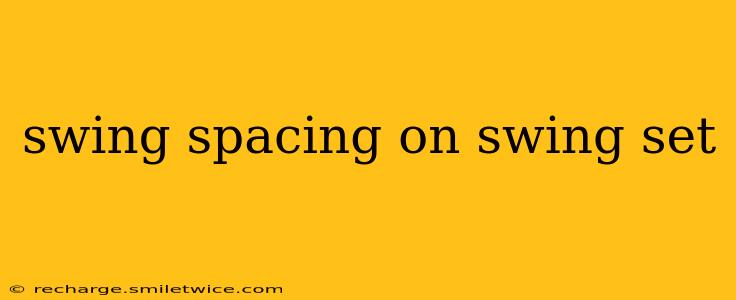Choosing the right swing spacing on your swing set is crucial for ensuring both safety and enjoyment for your children. Proper spacing prevents collisions, allows for comfortable swinging, and contributes to a positive play experience. This guide will delve into the ideal swing spacing, addressing common questions and concerns.
What is the recommended distance between swings?
The recommended distance between swings is generally between 24 and 36 inches (61 to 91 cm). This spacing provides ample room for children to swing freely without risking a collision. However, the exact spacing may need to be adjusted based on the size of the swings and the age and size of the children using them. Larger swings, or swings intended for older children, may require slightly more space. Conversely, smaller swings for toddlers can sometimes be spaced slightly closer together.
How far apart should swing chains be?
While swing spacing focuses on the distance between the swing seats themselves, the distance between the chains is also a critical safety consideration. Ideally, there should be enough space between chains that they do not tangle or interfere with each other during swinging. This is particularly important when installing multiple swings on a single beam. Aim for at least 2 inches (5 cm) of separation between chains to prevent any accidental entanglement. Consult the manufacturer’s instructions for your specific swing set model, as they often provide detailed spacing recommendations.
What is the minimum distance between swings?
While 24 inches is the recommended minimum distance, we strongly advise against going below this measurement. Trying to save space by reducing the distance between swings compromises safety and could lead to accidents. Remember, children can swing with varying degrees of intensity, and less space increases the risk of collisions. Prioritize safety over saving a few inches of space.
How much space should be around a swing set?
Beyond the spacing between swings, you should also consider the space surrounding the entire swing set. This area needs to be free of obstructions and allow for a safe swinging radius. Ideally, ensure there's at least 6 feet (1.8 meters) of clear space around the entire structure. This prevents children from colliding with walls, fences, or other objects during their swing motion. This is especially vital for swings that may have a wider swing arc. Planting soft landscaping like grass or mulch, instead of hard surfaces, will also help cushion any accidental falls.
How do I ensure my swing set has the correct spacing?
Before installing your swing set, carefully review the manufacturer's instructions. These usually provide detailed specifications for swing spacing and overall installation. If you're unsure about the correct spacing, consult a professional or seek advice from experienced DIY enthusiasts. Measure and double-check the distance between swings multiple times to ensure accurate and safe placement. You might even want to temporarily install the swings at the desired distances to visualize how much space is available before permanently attaching them to the frame.
Can I add more swings later?
Adding additional swings to an existing swing set might require modifications to the structure or beam. Always consult the manufacturer's instructions or a qualified professional to ensure that adding more swings will not compromise the structural integrity of your swing set. Adding swings without proper assessment could potentially lead to instability or even collapse, creating a serious safety hazard.
By following these guidelines and prioritizing safety, you can create a fun and safe play environment for your children with properly spaced swings. Remember, a few extra inches can make a significant difference in preventing accidents.
